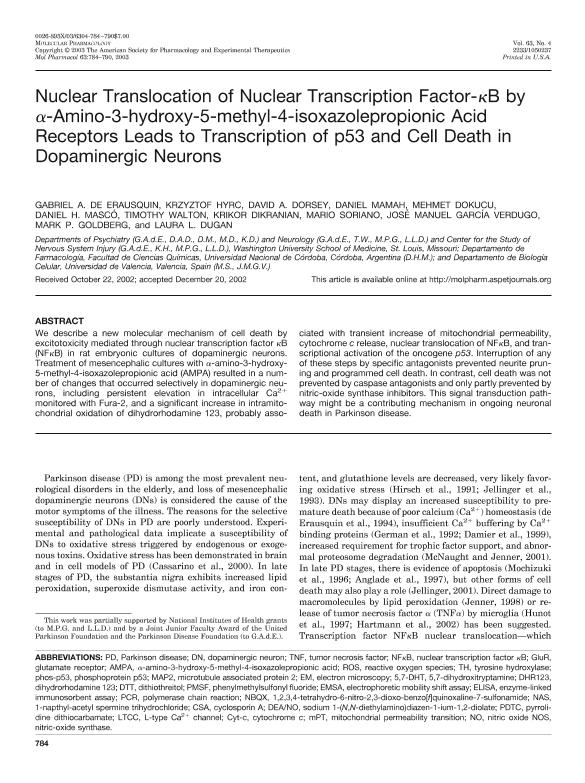Artículo
Nuclear translocation of nuclear transcription factor-κB by α-amino-3-hydroxy-5-methyl-4-isoxazolepropionic acid receptors leads to transcription of p53 and cell death in dopaminergic neurons
de Erausquin, Gabriel Alejandro; Hyrc, Krzyztof; Dorsey, David A.; Mamah, Daniel; Dokucu, Mehmet; Masco, Daniel Hugo ; Walton, Timothy; Dikranian, Krikor; Soriano, Mario; Garcia Verdugo, José Manuel; Goldberg, Mark P.; Dugan, Laura L.
; Walton, Timothy; Dikranian, Krikor; Soriano, Mario; Garcia Verdugo, José Manuel; Goldberg, Mark P.; Dugan, Laura L.
 ; Walton, Timothy; Dikranian, Krikor; Soriano, Mario; Garcia Verdugo, José Manuel; Goldberg, Mark P.; Dugan, Laura L.
; Walton, Timothy; Dikranian, Krikor; Soriano, Mario; Garcia Verdugo, José Manuel; Goldberg, Mark P.; Dugan, Laura L.
Fecha de publicación:
01/04/2003
Editorial:
American Society for Pharmacology and Experimental Therapeutics
Revista:
Molecular Pharmacology
ISSN:
0026-895X
e-ISSN:
1521-0111
Idioma:
Inglés
Tipo de recurso:
Artículo publicado
Clasificación temática:
Resumen
We describe a new molecular mechanism of cell death by excitotoxicity mediated through nuclear transcription factor κB (NFκB) in rat embryonic cultures of dopaminergic neurons. Treatment of mesencephalic cultures with α-amino-3-hydroxy-5-methyl-4-isoxazolepropionic acid (AMPA) resulted in a number of changes that occurred selectively in dopaminergic neurons, including persistent elevation in intracellular Ca2+ monitored with Fura-2, and a significant increase in intramitochondrial oxidation of dihydrorhodamine 123, probably associated with transient increase of mitochondrial permeability, cytochrome c release, nuclear translocation of NFκB, and transcriptional activation of the oncogenep53. Interruption of any of these steps by specific antagonists prevented neurite pruning and programmed cell death. In contrast, cell death was not prevented by caspase antagonists and only partly prevented by nitric-oxide synthase inhibitors. This signal transduction pathway might be a contributing mechanism in ongoing neuronal death in Parkinson disease.
Palabras clave:
Parkinson Disease
,
Nuclear Transcription
,
Cell Death
Archivos asociados
Licencia
Identificadores
Colecciones
Articulos(IIBYT)
Articulos de INSTITUTO DE INVESTIGACIONES BIOLOGICAS Y TECNOLOGICAS
Articulos de INSTITUTO DE INVESTIGACIONES BIOLOGICAS Y TECNOLOGICAS
Citación
de Erausquin, Gabriel Alejandro; Hyrc, Krzyztof; Dorsey, David A.; Mamah, Daniel; Dokucu, Mehmet; et al.; Nuclear translocation of nuclear transcription factor-κB by α-amino-3-hydroxy-5-methyl-4-isoxazolepropionic acid receptors leads to transcription of p53 and cell death in dopaminergic neurons; American Society for Pharmacology and Experimental Therapeutics; Molecular Pharmacology; 63; 4; 1-4-2003; 784-790
Compartir
Altmétricas



